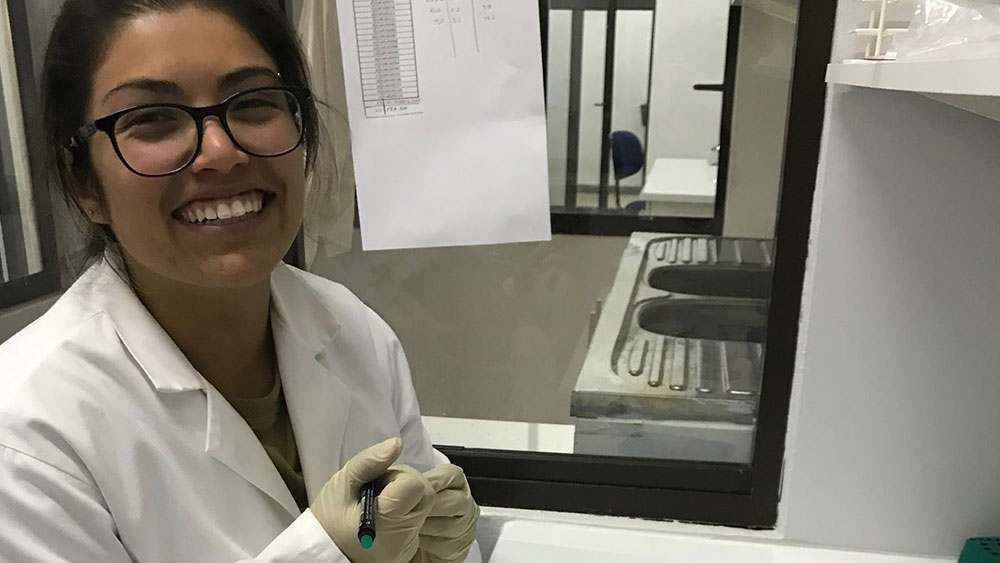The Dung and the DNA Diaries Part II: The Elephanthood of the Traveling Dung
-

- by Mireille Vargas October 25, 2018

My adventure to the Cheetah Conservation Fund (CCF) started in early July when, Sergio Redondo, a friend and a PhD student I had worked with earlier this year texted me about Dr. O’Connell-Rodwell, the esteemed elephant expert and co-founder of Utopia Scientific, and an Adjunct Professor in Stanford Department of Otolaryngology, Head & Neck Surgery, searching for a genetics intern to continue the work on the elephant scat collected in Namibia’s acclaimed Etosha National Park. She had received a Vice Provost of Undergraduate Education (VPUE) grant to support the participation of another Stanford student to continue the project.
At that time, I was working on environmental justice issues in the central coast of California, a passion of mine that I have pursued for years, and the chance to work on conservation was a route in my career that I had yet to explore. The conservation and further study of African elephant societies is especially essential since elephants are keystone species that have been targeted in the illegal wildlife trade for their ivory. These species contribute to the rest of the African ecosystem by providing water through digging wells with their feet and tusks, dispersing seeds and providing food through their dung. Elephants live in matriarchal societies and prior research has shown that the next oldest, wisest female becomes the new matriarch when the previous one passes. In a desert society, where resources are scarce, Dr. O’Connell-Rodwell has noticed differences in how matriarchies are structured. She hypothesized that, rather than the next oldest, wisest, the closest female relation to the matriarch becomes the next leader. If this turns out to be the case, there may be a queen ethos in desert elephant societies versus the more egalitarian structure of environments where resources are more abundant. This would mean that elephants that live in different habitats may have different cultures. In order to test her hypothesis, she and her team collected genetic samples from known individuals within and between family groups at her field site in Etosha National Park, by collecting their dung after the elephants left the waterhole. Now, after years of collecting the dung, Dr. O’Connell-Rodwell was focusing on analyzing the samples and searching for genetics interns to start fitting pieces of the puzzle together, to determine who is related to whom and if the dominance hierarchy is based on relatedness or age.
I knew that the opportunity to travel to Namibia and work in a lab where extraction, PCR, and microsatellite results happen in one space was rare. Within two hours of first receiving the text, I replied that I was available and got in contact with Dr. O’Connell-Rodwell. The following weeks before my departure were a whirlwind of getting the required papers ready and being updated of how the project was going, where Katie Lawlor, a PhD student at Stanford’s psychology department who had spent her last two summers working with Dr. O’Connell-Rodwell on observing elephant behavior and now was working in the CCF genetics laboratory on testing primer mixes to get the best microsatellite results.

I was thankful that despite the span of over 15,000 kilometers and the nine-hour time difference, I could count on Katie for advice on what to bring and help for my traveling documents especially since when I arrived to CCF, Katie had left only a few days prior.
Once situated at the conservation, work on the elephant dung quickly began. Picking up from where Katie had left off, I continued extracting DNA from the elephant dung and started setting up PCRs. Being in the genetics lab felt like being a detective. When results from the Gene Analyzer didn’t turn out well it was up to us to figure out why. Is the DNA concentration too low? Should we clean up the DNA with Gene Clean or Microcons after the extraction? Was there PCR product in the sample’s well?
There was never a dull day at Cheetah Conservation Center. Days not in the genetics lab were filled with feeding the livestock guarding dogs, which are raised and trained to protect farmer’s small livestock from predators to stop farmers from shooting cheetahs, and participating in the cheetah run, where the cheetahs get their exercise from chasing after cloth being dragged at high speeds. Afternoons were spent playing volleyball and frisbee with the other interns, and nights were reserved for playing Scrabble where we tried to unsuccessfully beat Helena, one of the other genetic interns.
Now my thirty days are almost to a close, and although my second year in undergrad is about to start in less than a week, school is the furthest thing on my mind. Throughout my experiences I have grown as a scientist and as a conservationist. Helping with the cheetah workups and the guarding dogs has taught me that conservation means approaching the issue from multiple sides, from prevention of cheetahs being killed by farmers through the guarding dog program to cautionary measures with the cheetah workups. These thirty days have also brought me close to my genetics team: Nina, William, Helena, Hafeni, and Monika. Working with them has taught me that time is not needed to create strong, lasting friendships.
Related Reading
-
December 3, 2023
Paws, Prints and DNA: Chronicles of a Genetics Intern -
June 15, 2023
Internship in the Ecology Department -
June 10, 2023
An Internship with Naughty Goats and Chocolates




